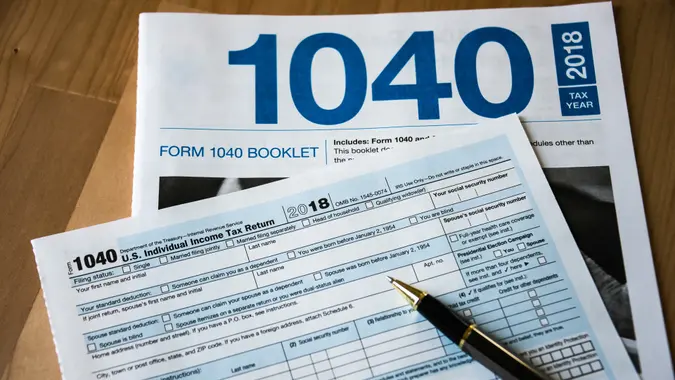10 Tax Breaks Every Middle-Class Family Should Take Advantage Of in 2025

Commitment to Our Readers
GOBankingRates' editorial team is committed to bringing you unbiased reviews and information. We use data-driven methodologies to evaluate financial products and services - our reviews and ratings are not influenced by advertisers. You can read more about our editorial guidelines and our products and services review methodology.

20 Years
Helping You Live Richer

Reviewed
by Experts

Trusted by
Millions of Readers
It doesn’t take a high income to land in a high tax bracket. A single adult earning $48,000 finds themselves paying 22% on their top-taxed dollars.
So how can middle-class families slash their tax bill, to keep more of what they earn and put it toward improving their lives? Try these tax breaks available to middle-class families in 2025.
Earned Income Tax Credit (EITC)
Moderate-income families can qualify for the EITC on their 2024 taxes — filed in 2025 — if they earn up to $66,819 as a couple filing jointly or $59,899 filing single.
With one child, families can take a credit up to $4,213. That jumps to $6,960 for families with two children, and $7,830 for those with three or more qualifying children. See the full table from the IRS showcasing the income limits based on the number of children you have.
Best of all for lower-earning families, the EITC is refundable, so you can collect money from the IRS even if you don’t owe a cent in taxes.
Retirement Savings Contributions Credit (Saver’s Credit)
Another credit for families with modest income, the Saver’s Credit supercharges the tax savings on retirement contributions.
“The Saver’s Credit rewards low-to-moderate-income earners with up to 50% back on retirement contributions,” explained Sharon Hayut, managing director at Magnus Financial Group. “It offers a maximum tax credit of up to $2,000 for individuals and $4,000 for couples.”
In addition to the deduction, these taxpayers can take the full credit amount directly off their tax bill. The credit is based on 10%-50% of the amount you contribute to a qualified retirement account, with the percentage based on your income.
Self-Employment Deductions
In today’s economy, many Americans work side gigs — or run a small business as their main gig. Fortunately for them, they can often take tax deductions through their business.
For example, small businesses can make charitable contributions and deduct the full amount, up to 25% of their taxable income. Likewise, self-employed workers can pay for business-related travel, mileage and meals as business expenses.
They may even be able to take the ever-rarer home office deduction, but beware of strict IRS rules about home offices.
Deduct Contributions to Tax-Sheltered Accounts
Middle-class families can deduct from their taxable income the amount they contribute to tax-sheltered accounts.
These accounts include retirement accounts, such as IRAs, 401(k) plans and 403(b) plans, and also health savings accounts (HSAs). You lower your tax bill today, and invest money for tomorrow. Consider it a win-win.
The ability to deduct contributions does phase out at a certain income level, but higher earners can contribute, forgo the deduction, and then convert the funds to a Roth IRA to circumvent the Roth IRA income limits. Tax nerds refer to this as a backdoor Roth contribution.
Tax-Free Compounding and Withdrawals
The money you invest through Roth retirement accounts and HSAs compounds tax-free. And you pay no taxes on withdrawals later, either.
“The best tax-advantaged account in the U.S. is the health savings account,” said Scott Sturgeon, founder of Oread Wealth Partners. “You have to enroll in a high deductible health plan to have those accounts, which is generally more expensive from a deductible perspective, but when you do the math and factor in the tax savings, it’s often a better deal than a PPO plan.”
It’s the only account that offers both tax-free contributions and withdrawals.
“No other account offers benefits like that, and for higher-earning middle-class families, those tax breaks alone can make it worth it over a PPO plan,” Sturgeon explained.
In fact, some Americans use HSAs as a secondary retirement account. They know they’ll have no shortage of qualified health expenses in retirement, after all. And withdrawals for non-medical expenses are tax free after age 65.
Tax Loss Harvesting
Have capital gains or investment income that drag up your tax bill? Consider tax loss harvesting.
It works like this: You sell investments that have taken a loss, then immediately buy similar investments, so there’s little substantive change to your investment portfolio. For example, say you bought shares in a small-cap stock fund a year or two back, and the market tanked. You sell your shares and immediately buy new shares in a mid-cap stock fund.
You then show the loss on your tax return, to offset gains from other investments.
Child Tax Credit
“The Tax Cuts and Jobs Act of 2017 doubled the Child Tax Credit from $1,000 to $2,000,” explained Nicolette Davicino, financial advisor at Armstrong, Fleming & Moore, Inc. “In addition, it increased the refundable amount and increased the income phaseout threshold from $75,000 to $200,000 — so many more Americans qualify now.”
Single parents earning up to $200,000 per year and married couples earning $400,000 can take the full child tax credit of $2,000 per child. Parents who earn more can still take the credit, but it drops by 5% of adjusted gross income over that threshold.
Families with income low enough that they don’t owe any federal income taxes still qualify for $1,700 per child as the refundable portion of the tax credit.
Child and Dependent Care Credit
To make it more affordable for parents and other caregivers to work full-time, the IRS offers a tax credit equal to 20%-35% of care expenses. The Child and Dependent Care Credit maxes out at $3,000 for one dependent and $6,000 for two or more.
The credit applies not just to minor children, but also aging parents, disabled relatives and others who need significant care.
Lifetime Learning Credit and American Opportunity Tax Credit
Taxpayers can claim both of these credits on the same tax return — but not for the same student or expenses. You have to pick one or the other for each student you want to claim.
Hayut said, “The Lifetime Learning Credit offers up to $2,000 per tax return for qualified education expenses, regardless of the number of students. For 2025, married couples filing jointly with modified adjusted gross income (MAGI) under $160,000 can claim the full credit, with a phase-out up to $180,000.”
The American Opportunity Tax Credit allows a deduction up to $2,500 per student, and up to 40% of it is refundable for lower-earning taxpayers.
Disaster-Related Deductions
Typically, a taxpayer can only deduct for unreimbursed disaster-related losses if they exceed 10% of their adjusted gross income.
In December 2024 however, former President Joe Biden signed the Federal Disaster Tax Relief Act of 2023, allowing victims of federally-declared disasters to deduct unreimbursed losses if they exceed $500. The law applies between January 1, 2020, and February 2025.
Note that the IRS allows disaster deductions “above the line,” meaning you don’t have to itemize your deductions to take it. In other words, you can still take the standard deduction while also deducting disaster-related losses.
 Written by
Written by  Edited by
Edited by 

























